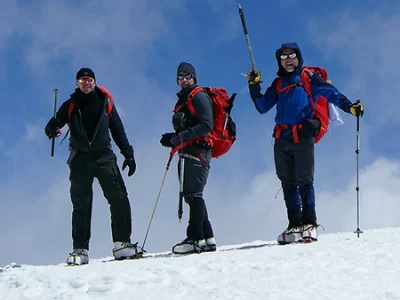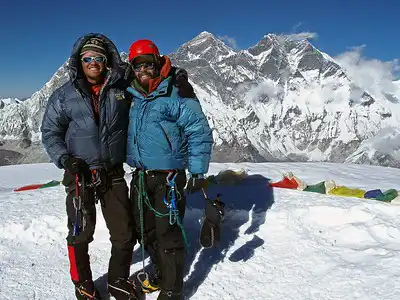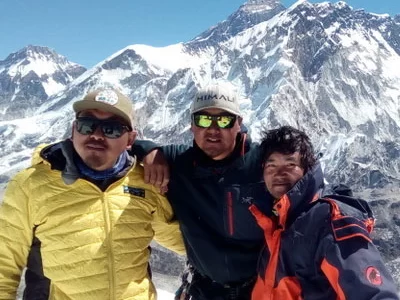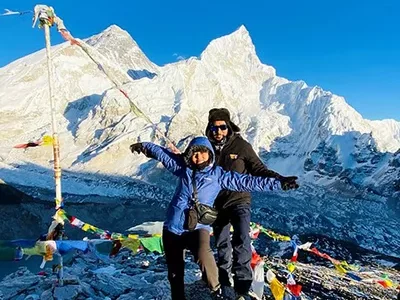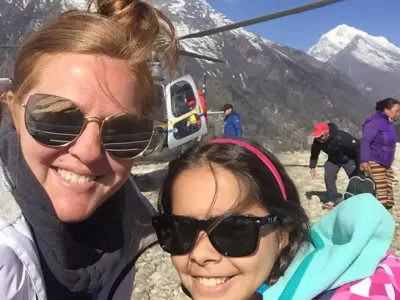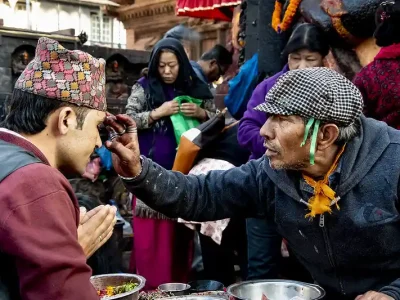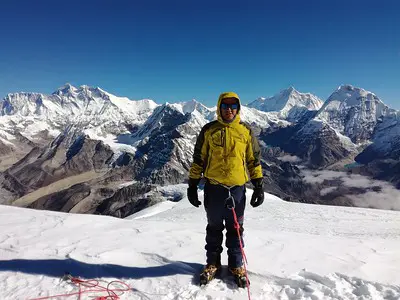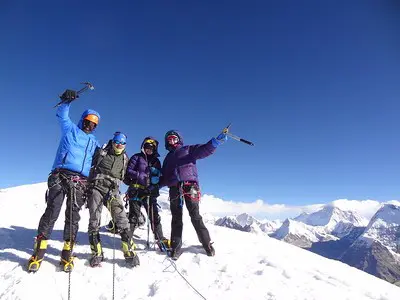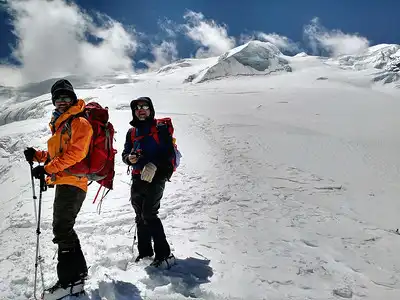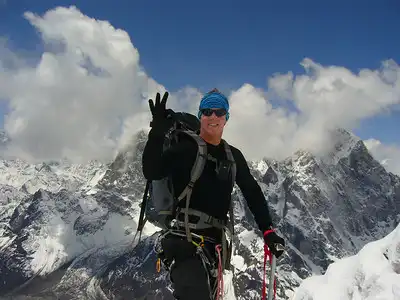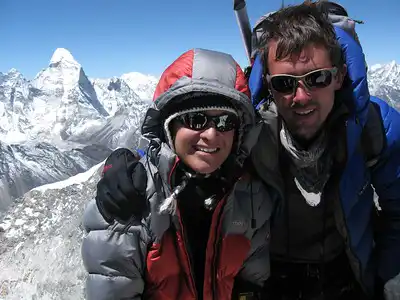Mera Peak, towering at 6,476 meters, is the highest trekking peak in Nepal and attracts many climbers and trekkers every year. Situated in the Solu Khumbu region, it offers breathtaking views of Everest, Makalu, and other towering Himalayan peaks. Its non-technical nature makes it accessible to many adventure seekers with minimal mountaineering experience. However, securing a Mera Peak climbing permit is crucial for anyone planning this climb.
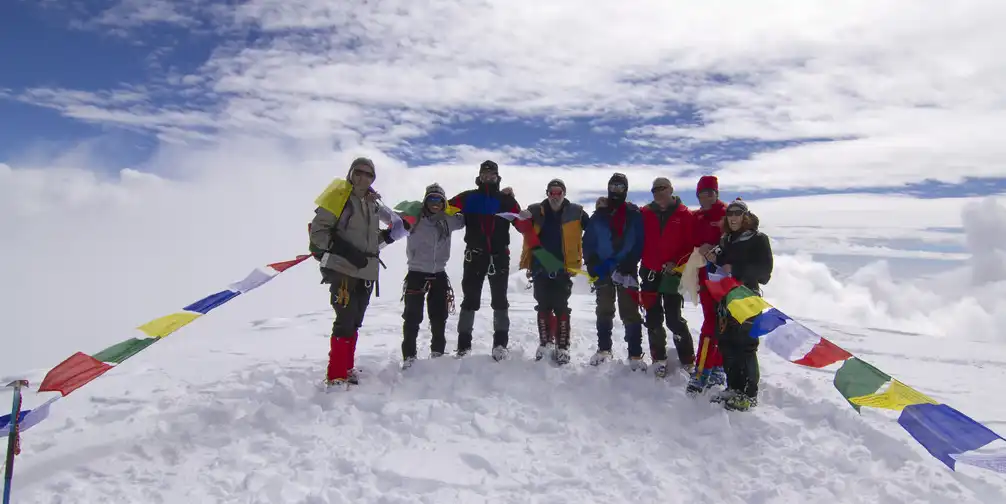
To access the mountain legally, every climber must have a Mera Peak climbing permit issued by the Nepal Mountaineering Association (NMA). The permit plays a key role in protecting the environment and promoting responsible trekking practices. Without this permit, trekkers risk facing penalties and impacting the region’s delicate ecosystems.
Importance of Obtaining the Correct Permits for Safety and Legal Reasons
- Ensure Legal Compliance: Climbing Mera Peak without a permit may result in fines or other legal repercussions. Having a permit ensures that you follow the necessary rules.
- Protect the Environment: Permits help manage the number of climbers, reducing environmental damage and preserving the area’s natural beauty.
- Follow Safety Protocols: The correct permits ensure climbers pass through monitored checkpoints, increasing safety throughout the trek.
- Support Local Communities: Fees collected from permits contribute to the local economy and help improve trekking infrastructure.
- Receive Emergency Assistance: If an emergency arises, a valid permit makes it easier for authorities to provide assistance and coordinate rescues.
Mera Peak Climbing
Island Peak Climbing with EBC Trek
Ama Dablam Expedition
Essential Permits for Climbing Mera Peak
Before you start on the Mera Peak climb, securing the necessary permits is crucial for a legal and safe adventure. In the Solu Khumbu region of Nepal, Mera Peak requires climbers to obtain various licenses due to the area’s specific administrative and geographical divisions. Here’s a comprehensive breakdown of the required permits, which Peregrine Treks and Tours can efficiently arrange for you.
Makalu Barun National Park Entry Permit
Every climber heading to Mera Peak needs a Makalu Barun National Park Entry Permit, as the peak falls within this protected area. This permit grants you access to the park and aids in conserving its diverse ecosystems.
- Purpose: This permit is vital for supporting the park’s conservation initiatives, which protect its unique wildlife and landscapes.
- Acquisition: You can obtain this permit through Peregrine Treks and Tours in Kathmandu or at various park entry points.
- Cost: It generally costs around NPR 3,000 for foreign nationals, with minor variations for SAARC nationals.
Khumbu Pasang Lhamu Rural Municipality Permit
As you trek through the Khumbu region towards Mera Peak, you’ll also need a Khumbu Pasang Lhamu Rural Municipality Permit. This permit is crucial for accessing areas under the local municipality’s jurisdiction.
- Purpose: The fee for this permit supports maintaining and enhancing the region’s infrastructure and trekking paths.
- Acquisition: Peregrine Treks and Tours can secure this permit in Kathmandu or at designated checkpoints along your route.
- Cost: This permit costs NPR 2,000 for foreign nationals, directly supporting the local communities.
Mera Peak Climbing Permit
The most critical permit for your climb is the Mera Peak climbing permit, issued by the Nepal Mountaineering Association (NMA). This permit is mandatory for anyone aiming to summit Mera Peak and varies in cost by season:
- Spring (March to May): USD 250
- Autumn (September to November): USD 125
- Winter (December to February): USD 70
- Summer (June to August): USD 70
- Purpose: This permit legally authorizes your climb, contributing to the mountain’s safety protocols and conservation efforts.
- Acquisition: Peregrine Treks and Tours will facilitate obtaining this permit from the NMA office in Kathmandu.
Connection of Each Permit to Different Trek Sections
- Makalu Barun National Park Entry Permit: This permit covers the initial parts of the trek that meander through the park’s protected zones.
- Khumbu Pasang Lhamu Rural Municipality Permit: Essential for the segments of the trek that traverse the Khumbu area, this permit supports local upkeep and development.
- Mera Peak Climbing Permit: This document is crucial for the final ascent above 5,800 meters, ensuring you have authorized access to reach the summit.
Lobuche Peak Climbing
Everest Base Camp Trek
Everest Base Camp Trek with Helicopter Return
Permit Costs and Fees for Mera Peak Climbing
The proper permits are crucial for a smooth and legal climb of Mera Peak. You can prepare effectively by understanding the breakdown of costs and payment methods. The Mera Peak climbing permit and other essential permits vary in price depending on the season and the regions you pass through. Below is a detailed overview of the permit costs and how to obtain them.
Breakdown of Permit Costs
To climb Mera Peak legally, you must secure several permits. Here’s a detailed look at the costs:
-
Makalu Barun National Park Entry Permit
- Cost: Around NPR 3,000 for foreign nationals.
- Purpose: This permit grants you access to the Makalu Barun National Park and helps fund conservation efforts to protect the region’s biodiversity.
-
Khumbu Pasang Lhamu Rural Municipality Permit
- Cost: NPR 2,000 for foreign nationals.
- Purpose: This permit allows access to the Khumbu region, with fees supporting local infrastructure, trail maintenance, and community development.
-
Mera Peak Climbing Permit
Issued by the Nepal Mountaineering Association (NMA), this permit is essential for climbing Mera Peak. The cost varies by season:
- Spring (March to May): USD 250
- Autumn (September to November): USD 125
- Winter (December to February): USD 70
- Summer (June to August): USD 70
- Purpose: The Mera Peak climbing permit ensures you have legal authorization to climb and contributes to the conservation and safety measures in the area.
Seasonal Variation in Mera Peak Climbing Permit Fees
The cost of the Mera Peak climbing permit depends on the season. Here’s why:
- Spring (March to May): Spring is Mera Peak’s busiest season, so the permit fee is USD 250. However, the favorable weather and clear paths attract many climbers.
- Autumn (September to November): The cost drops to USD 125 during autumn, as the weather remains favorable, but there are fewer climbers compared to spring.
- Winter (December to February): The fee decreases to USD 70 due to challenging winter conditions, including cold temperatures and snowfall.
- Summer (June to August): Summer brings monsoon rains, making the trails more difficult, so the permit remains at USD 70.
How and Where to Pay for the Permits
You can pay for the Mera Peak climbing permit and other required permits using several convenient methods:
- At designated offices in Kathmandu: You can visit the Nepal Mountaineering Association (NMA) office to pay for the Mera Peak climbing permit. Other permits, like the Makalu Barun National Park Entry Permit and Khumbu Pasang Lhamu Rural Municipality Permit, are available here.
- At checkpoints along the trekking route: Some permits can be purchased at checkpoints during the trek, such as in Lukla or other entry points.
- Through trekking agencies: Many climbers prefer using authorized trekking agencies, such as Peregrine Treks and Tours, to handle all the permits. The agency arranges everything, including the payment and documentation, saving you time and effort.
How to Secure Your Mera Peak Climbing Permit
Securing a Mera Peak climbing permit is essential for anyone planning to scale this breathtaking Himalayan peak. Knowing the necessary steps and preparing the required documents can streamline the process. This guide details how to obtain your permit efficiently, emphasizing the support trekking agencies can provide.
Steps to Acquire the Mera Peak Climbing Permit
You have several options for obtaining your Mera Peak climbing permit, whether you choose to do it yourself or enlist the help of a trekking agency. Here’s what you need to know:
-
Visit the Nepal Mountaineering Association (NMA) Office
- You can apply for the Mera Peak climbing permit directly at the NMA office in Kathmandu. This method is the most straightforward way to secure your permit.
- Ensure you bring all necessary documents (details provided below).
-
At Trekking Checkpoints
- Although permits can be obtained at various trekking checkpoints, obtaining your Mera Peak climbing permit is advisable to ensure the earliest possible delays.
-
Online Application
- Some trekking agencies offer the convenience of applying for your permit online. Always verify this option with your chosen agency to ensure availability.
Required Documents for the Mera Peak Climbing Permit
To apply for the Mera Peak climbing permit, you must prepare several key documents to prove your eligibility and comply with legal requirements.
- Passport: A valid passport is crucial for identification and processing your permit application.
- Nepal Visa: You must ensure that your Nepal visa covers the entire period of your stay. Upon arrival at Tribhuvan International Airport or from a Nepalese embassy or consulate in your home country, you can obtain a visa.
- Passport-Sized Photos: They will likely ask you to provide at least two recent passport-sized photos.
- Travel Insurance: Take out an all-inclusive assurance cover for the trip, including backcountry trekking at high elevations. In some regions, climbers must have insurance before they are allowed to proceed.
- Trekking Itinerary: Provide a detailed itinerary that outlines your planned route and timing, assisting authorities in monitoring your trek safely.
Role of Trekking Agencies in Facilitating Permit Acquisition
Trekking agencies are invaluable in simplifying the permit process, particularly for climbers unfamiliar with the procedures or constrained by time. Here’s how they can help:
- Document Management: Peregrine Treks and Tours will collect and organize all necessary documents for you, ensuring they notice everything.
- Permit Applications: With their expertise in local regulations, these agencies can quickly secure your Mera Peak climbing permit from the NMA, saving you significant time and hassle.
- Logistical Support: In addition to managing permits, trekking agencies can coordinate additional logistics such as transportation, accommodations, and equipment, enhancing your overall trekking experience.
Understanding Permit Validity and Regulations for Mera Peak Climbing
Before you start your Mera Peak adventure, grasping the nuances of the Mera Peak climbing permit’s validity and the associated rules is crucial. This permit facilitates legal access and upholds your commitment to a safe and ecologically respectful climbing experience. Here’s an in-depth look at what you need to know about permit validity, access restrictions, and key regulations for climbing Mera Peak.
Validity of the Mera Peak Climbing Permit
The Mera Peak climbing permit is valid for the entire duration of your trek, typically aligning with the dates specified in your trekking itinerary. Climbers usually complete their trip within 14 to 18 days. Ensuring that your permit’s validity corresponds with your planned trek dates is important to avoid legal issues. If unforeseen circumstances like weather delays extend your trek, contact your trekking agency or the local permit office to discuss extending your permit’s validity.
Restricted Areas and Special Permissions
Access to Mera Peak requires a Mera Peak climbing permit, but be aware of additional permissions for surrounding areas:
- Makalu Barun National Park: Since Mera Peak is located within this national park, securing a Makalu Barun National Park Entry Permit is necessary for protecting the area’s wildlife and natural environments.
- You need a Khumbu Pasang Lhamu Rural Municipality Permit to traverse the Khumbu region. With this permit, you can avoid penalties or denial of access.
- Special Restricted Areas: Some regions around Mera Peak are particularly sensitive and require special trekking permits to protect local communities and ecosystems. Always comply with all access rules for these areas.
Essential Regulations for Climbers
Climbers must adhere to specific regulations to ensure safety and environmental preservation during their Mera Peak trek. Here are some critical guidelines:
-
Environmental Conservation
- Adhere to a strict “Leave No Trace” policy. Pack out all your waste and minimize your environmental footprint.
- Do not disturb the wildlife or the natural vegetation. Stay on marked trails to avoid erosion and damage to habitats.
- Carry out all trash to keep the trails and campsites clean.
-
Respecting Local Customs and Traditions
- Honor the local culture and customs. The Khumbu region is predominantly Sherpa, and respecting their cultural practices is essential.
- Wear modest clothing and conduct yourself respectfully in villages, monasteries, and near sacred sites.
- Always seek consent before taking photos of local people or their religious icons.
-
Climbing Safety Guidelines
- Heed your guide’s advice diligently. Guides are well-versed in the local terrain and climatic conditions, which enhances your safety.
- Properly equip yourself with essential gear, such as crampons, ice axes, and ropes, especially at higher altitudes.
- Keep to the designated climbing routes to avoid unsafe areas.
FAQ: Navigating the Mera Peak Climbing Permit Process
Planning your ascent to Mera Peak raises several important questions, particularly concerning the Mera Peak climbing permit. This FAQ section addresses common concerns to help you prepare effectively for your adventure. We’ll cover topics such as obtaining permits solo, the advisability of climbing without a guide, and what to do if you lose your permit or need an extension.
Can You Obtain a Mera Peak Climbing Permit as a Solo Climber?
Yes, you can secure a Mera Peak climbing permit for solo climbing. However, the Nepali government strongly advises that climbers hire a licensed guide for safety. Although solo climbs are permitted, having an experienced guide is invaluable, particularly through the challenging high-altitude terrain.
What Should You Do If Climbing Without a Guide?
Climbing Mera Peak without a guide is permissible but comes with significant risks. If you decide to climb without a guide, you should:
- Be experienced in high-altitude trekking and equipped with essential survival skills.
- Inform a reliable contact of your detailed itinerary and expected return.
- Carry effective communication tools for emergencies.
How to Manage a Lost Permit or Request an Extension
Losing your permit or needing to extend it due to unexpected delays like bad weather or health issues can complicate your trek. Here’s how to handle these situations:
If You Lose Your Permit
- Contact the closest checkpoint or the Nepal Mountaineering Association (NMA) office immediately.
- Provide identification and evidence of your original permit (keeping digital copies or photos is beneficial).
- Follow their instructions to obtain a replacement permit, which may involve a fee.
If Your Permit Needs to Be Extended
- Visit the NMA office in Kathmandu or talk to local authorities at the trekking checkpoints.
- You must present evidence justifying the need for an extension, such as medical records or weather reports.
- Ensure you remain legally compliant by applying for the extension before your permit expires.
Conclusion: The Importance of Securing Your Mera Peak Climbing Permit
The correct Mera Peak climbing permit is essential for this stunning Himalayan peak’s successful and legal ascent. Securing the right licenses ensures you comply with local regulations, support environmental conservation, and contribute to the safety of the trekking routes. These permits are necessary to avoid fines, legal issues, or denial of access to key areas.
Final Tips for a Smooth Permit Application Process
- Prepare Early: Before the trek, start the permit application process to avoid last-minute complications.
- Have All Documents Ready: Ensure you have a valid passport, Nepal visa, passport-sized photos, travel insurance, and a detailed trekking itinerary.
- Use a Trekking Agency: Consider hiring a licensed trekking agency like Peregrine Treks and Tours to handle the permit process and logistics. It can save you time and ensure everything is in order.
- Keep Copies: Always carry physical and digital copies of your permits in case of loss or damage during your trek.
- Check Permit Validity: Ensure your Mera Peak climbing permit covers the entire duration of your trek, and apply for an extension if necessary before your permit expires.

